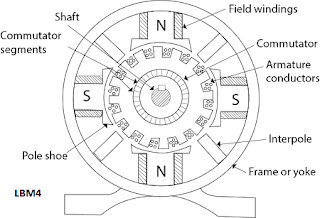Viva And Interview Questions on DC Generator
1.
Principle of operation of a generator?
Ans: An electric generator is a machine that
converts mechanical energy into electrical energy. An electric generator is
based on the principle that whenever flux is cut by a conductor, an e.m.f. is
induced which will cause a current to flow if the conductor circuit is closed.
The direction of induced e.m.f. (and hence current) is given by Fleming’s right
hand rule.
2. What is the role of a Commutator?
Ans:The function of
commutator is to facilitate the collection of current from armature conductors.
It converts the alternating current induce in the armature conductors into
unidirectional current in the external load circuit.
3.
What is the function of brushes?
Ans: The purpose of
brushes is simply to lead current from the rotating loop or winding to the
external stationary load.
4.
What are the different types of generators?
Ans: Generators are
generally classified based on their methods of field excitation
(i) Separately excited d.c. generators
(ii) Self-excited d.c. generators
(i) Separately excited d.c. generators
(ii) Self-excited d.c. generators
5.
How do you define separately excited generators?
Ans: A d.c. generator
whose field magnet winding is supplied from an independent external d.c. source
(e.g., a battery etc.) is called a separately excited generator.
6.
How do you define Self Excited Generators?
Ans: A d.c. generator
whose field magnet winding is supplied current from the output of the generator
itself is called a self-excited generator. There are three types of
self-excited generators depending upon the manner in which the field winding is
connected to the armature.
- Series generator – , the field winding is connected in series with armature winding so that whole armature current flows through the field winding as well as the load.
- Shunt generator – , the field winding is connected in parallel with the armature winding so that terminal voltage of the generator is applied across it.
- Compound generator – there are two sets of field windings on each pole—one is in series and the other in parallel with the armature. A compound wound generator may be:
- Short Shunt in which only shunt field winding is in parallel with the armature winding
- Long Shunt in which shunt field winding is in parallel with both series field and armature winding
7.
What are the different types of losses in DC Machines?
Ans: The losses in a
d.c. machine (generator or motor) may be divided into three types:
- Copper losses: These losses occur due to currents in the various windings of the machine.
- Iron or core losses: These losses occur in the armature of a d.c. machine and are due to the rotation of armature in the magnetic field of the poles. They are of two types
- Hysteresis loss: Hysteresis loss occurs in the armature of the d.c. machine since any given part of the armature is subjected to magnetic field reversals as it passes under successive poles.
- Eddy current loss: The voltages induced in the armature conductors produce circulating currents in the armature core known as eddy currents and power loss due to their flow is called eddy current loss. The eddy current loss appears as heat which raises the temperature of the machine and lowers its efficiency.
3. Mechanical
losses: These losses are due to friction and windage. These losses depend upon
the speed of the machine. But for a given speed, they are practically constant.
8.
What are constant and variable losses?
- constant losses: Iron losses, Mechanical losses, Shunt field losses
- Variable losses: Copper loss.
9.
Explain armature reaction?
Ans: Armature reaction
is the effect of magnetic field setup by armature current on the distribution
of flux under main poles of a generator. The armature magnetic field has two
effects
- It demagnetizes or weakens the main flux
- It cross-magnetizes or distorts it
The first effect leads to reduced generated voltage and second to the sparking
at the brushes.
10.
Why do we use compensation windings?
Ans: Compensation
windings are used to neutralize the cross magnetizing effect of armature
reaction.
11.
What if there are no compensation windings?
Ans: In the absence of
compensation windings the flux will be suddenly shifting backward and forward
with every change in load inducing an e.m.f in the armature coils. The
magnitude of this e.m.f may be so high as to strike an arc between the
consecutive commutator segments. This may further develop into a flash-over
around the whole commutator thereby short circuiting the whole armature.
12.
What is commutation?
Ans: The currents in
the coils connected to a brush are either all towards the brush (positive brush)
or all directed away from the brush (negative brush). Therefore, current in a
coil will reverse as the coil passes a brush. The reversal of current in a coil
as the coil passes the brush axis is called commutation.
13.
How do you improve Commutation?
Ans: Improving commutation means to make current reversal
in the short-circuited coil as spark less as possible. This can be done using
- Resistance commutation
- E.M.F. commutation
14.
What is voltage regulation?
Ans: The change in
terminal voltage of a generator between full and no load (at constant speed) is
called the voltage regulation. It is usually expressed as a percentage of the
voltage at full-load.%Voltage Regulation= (VNL-VFL)/VFL*100
VNL= Terminal voltage of generator at No load.
VFL= Terminal voltage of generator at full load.
VFL= Terminal voltage of generator at full load.
15.
What are the advantages of parallel operation of generators?
- Continuity of service
- Efficiency
- Maintenance and Repair
- Increasing plant capacity
- Non availability of single large u









No comments:
Post a Comment